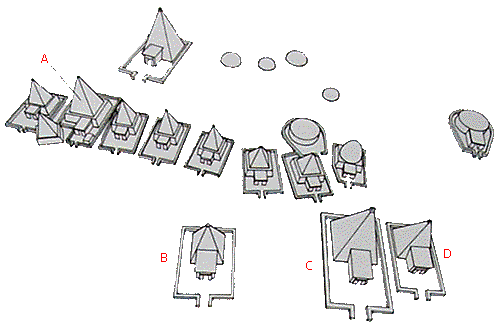![]()
|
Nubia was a reservoir of royal pyramids long after the had ceased to be built in Egypt itself. Above the IIIrd cataract the principle pyramid cementeries at el-Kurru, Gebel Barkal, Nuri and Meroe, were built about 180 pyramids. The Nubian sequence begins more than 800 years after the last royal pyramid was built in Egypt. |
The Pyramids of el-Kurru
|
El-Kurru lies on the right bank of the Nile, about 13 km south from the Gebel Barkal. Excavations directed by G.Reisner in 1918-19 discovered on the cementery pyramids, which stood above tombs of kings of XXV Dynasty: Piankhi, Shabaka, Shabataka and Tanutamon. Pyramid of Piankhi had a base length of about 8 m and a slope of probably about 68o. A stairway of 19 steps opened to the east and led to the burial chamber cut into the bedrock as an open trench and covered with a corbelled masonry roof. Piankhi's body had been placed on a bed which rested in the middle of the chamber on a stone bench with its four corners cut away to receive the legs of the bed, so that the bed platform lay directly on the bench. The pyramids of Piankhi cuccessors were similiar. There were also 14 queens pyramids at el-Kurru, 6 to 7 m square, compared to the 8 to 11 m of the king's pyramids. Northeast of the royal cementery, G.Reisner found the graves of 24 horses and two dogs. |
|
 |
A -
Kashta |
The Pyramids of Nuri
|
|
The pyramid field of Nuri contained 21 kings together with 52 queens and princesess . The first to build his tomb at Nuri was king Taharqa. His pyramid had 51.75 m square and 40 or 50 m high. Taharqa subterranean chambers are the most elaborate of any Kushite tomb. The entrance was by an eastern stairway trench , north of the pyramid's central axis, reflecting the alignment of the original smaller pyramid. Three steps led to a doorway, with a moulded frame, that opened to a tunnel, widened and heightened into an antechamber with a barrel-vaulted ceiling. Six massive pillars carved from the natural rock divide the burial chamber into two side aisles and a central nave, each with a barrel-vaulted ceiling. The entire chamber was surrounded by a moat-like corridor entered steps leading down from in front of the antechamber doorway. After Taharqa 21 kings and 53 queens and princesess were buried at Nuri under pyramids of good masonry, using blocks of local red sandstone. The Nuri pyramids were generally much larger than those at el-Kurru, reaching heights of 20 to 30 m. The last king to be buried at Nuri died in about 308 BC. A -
stairway
|
The Pyramids of Meroe
|
|
![]()
|
Copyright © 2000-2013 Dariusz Sitek, Czestochowa - Chicago - Ann Arbor |